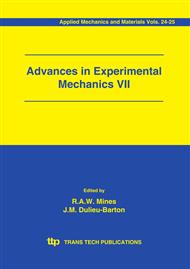p.189
p.195
p.201
p.207
p.213
p.221
p.227
p.233
p.239
On the Mutual Interactions of Monotonic and Cyclic Loading and their Effect on the Strength of Aluminium Alloys
Abstract:
The paper investigates the interaction of monotonic cyclic loading and their effect on the yield strength of aluminium alloy. Two different loading combinations were considered, i.e. torsion-reverse-torsion superimposed on monotonic tension and monotonic torsion combined with tension-compression cycles. All strain controlled tests were carried out at room temperature using thin-walled tubular specimens. The maximum value of the total cyclic strain amplitude was less than 1%. The influence of amplitude, frequency and shape of cyclic loading signal on the proportional limit and conventional yield point was investigated. The experimental results presented in the paper may be useful to designers of structures that utilize manufacturing processes such as drawing, extrusion, forging of selected semi-finished elements or researchers working on the development of new constitutive equations.
Info:
Periodical:
Pages:
213-218
Citation:
Online since:
June 2010
Authors:
Keywords:
Permissions:
Share:
Citation:


